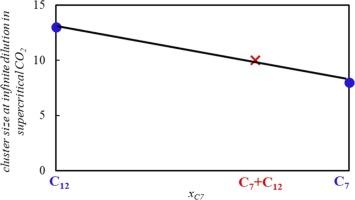探索CO₂+碳氢化合物混合物中的团簇形成:从二元到三元体系
IF 4.4
3区 工程技术
Q2 CHEMISTRY, PHYSICAL
引用次数: 0
摘要
本研究旨在研究二元和三元体系中含有正庚烷(n-C₇)和正十二烷(n-C₁₂)的超临界富CO₂混合物在无限稀释下的聚类现象。主要目的是了解溶质在三元混合物中的聚类行为是如何结合的,以及这种结合是否遵循加性规则。为此,密度测量在313.15 K和323.15 K下进行,压力范围为(10−70)MPa,可以确定部分摩尔体积作为聚类的指标。结果表明,在低压(低于20 MPa)条件下,二元和三元体系均存在明显的聚类效应,其偏摩尔体积为负,表明在溶质周围形成紧密的溶剂化团簇。在三元混合物中,基于二元体系中观察到的团簇的摩尔分数,发现团簇行为遵循近线性组合。这表明CO₂+ 多溶质体系中的聚类可以通过二元行为来预测。使用两个saft型状态方程(PC-SAFT和SAFT-VR Mie)来评估它们从二元系统到三元系统转换的建模能力。虽然两者都捕获了非理想的体积行为,但SAFT-VR Mie表现出更好的定量一致性。这些发现提高了我们对富含CO 2环境中溶质-溶剂相互作用的理解,并支持了超临界萃取、碳捕集与封存(CCUS)和提高石油采收率(EOR)等过程的增强建模。本文章由计算机程序翻译,如有差异,请以英文原文为准。

Exploring cluster formation in CO₂ + hydrocarbon mixtures: From binary to ternary systems
This study aims to investigate clustering phenomena at infinite dilution in supercritical CO₂-rich mixtures with n-heptane (n-C₇) and n-dodecane (n-C₁₂), in both binary and ternary systems. The main objective is to understand how the individual clustering behaviors of the solutes combine in the ternary mixture, and whether this combination follows an additive rule. To this end, density measurements were carried out at 313.15 K and 323.15 K over a pressure range of (10−70) MPa, enabling the determination of partial molar volumes as indicators of clustering. The results reveal a pronounced clustering effect at low pressures (below 20 MPa) for both binary and ternary systems, as evidenced by strongly negative partial molar volumes, which indicate the formation of compact solvation clusters around the solutes. In the ternary mixture, the clustering behavior was found to follow a nearly linear combination, based on the mole fractions of the clusters observed in the binary systems. This suggests that clustering in CO₂ + multi-solute systems may be predicted from binary behavior.
Two SAFT-type equations of state (PC-SAFT and SAFT-VR Mie) were employed to evaluate their ability to model the transition from binary to ternary systems. While both captured the non-ideal volumetric behavior, SAFT-VR Mie demonstrated better quantitative agreement. These findings improve our understanding of solute–solvent interactions in CO₂-rich environments and support enhanced modeling of processes such as supercritical extraction, carbon capture and storage (CCUS), and enhanced oil recovery (EOR).
求助全文
通过发布文献求助,成功后即可免费获取论文全文。
去求助
来源期刊

Journal of Supercritical Fluids
工程技术-工程:化工
CiteScore
7.60
自引率
10.30%
发文量
236
审稿时长
56 days
期刊介绍:
The Journal of Supercritical Fluids is an international journal devoted to the fundamental and applied aspects of supercritical fluids and processes. Its aim is to provide a focused platform for academic and industrial researchers to report their findings and to have ready access to the advances in this rapidly growing field. Its coverage is multidisciplinary and includes both basic and applied topics.
Thermodynamics and phase equilibria, reaction kinetics and rate processes, thermal and transport properties, and all topics related to processing such as separations (extraction, fractionation, purification, chromatography) nucleation and impregnation are within the scope. Accounts of specific engineering applications such as those encountered in food, fuel, natural products, minerals, pharmaceuticals and polymer industries are included. Topics related to high pressure equipment design, analytical techniques, sensors, and process control methodologies are also within the scope of the journal.
 求助内容:
求助内容: 应助结果提醒方式:
应助结果提醒方式:


